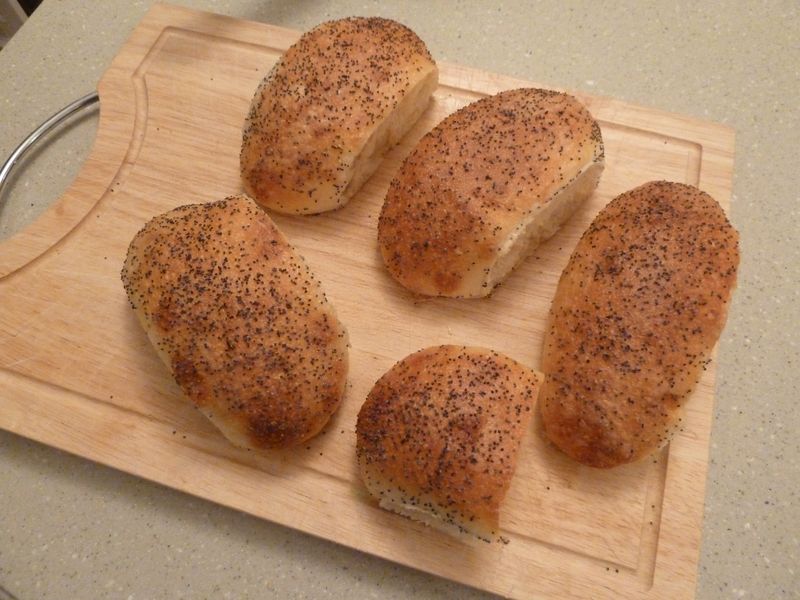Hi,
I've just made some soft Italian rolls from Reinhart's BBA. They turned out nicely, springing up substantially in the oven, but all the loaves had the same flaw: a clear layer just under the upper crust of oversized air pockets and stretched-to-breaking-point gluten strands.
Here's a few pictures:

Rolls looked very nice and had a soft, golden brown crust.

An example of the large air cells and stretched gluten strands.

Another roll pictured from the long side where it joined another. You can see the gap running along it at the top.
Some notes:
- I shaped these by rolling them into round balls first, resting them for 15 min, then shaping them like mini batards (gently flattening them out and rolling the top edge down a couple of times, trying to create surface tension, then rolling them on the counter to lengthen)
- The dough is similar to what I use for hamburger rolls, but I've never had similar gaps in those (though they bake in a slightly cooler oven)
- I made the same recipe a couple of days ago without the present problem, but those were (I believe) under-proofed due to the cold weather here - they ended up nice, but denser and smaller than these ones, which I proofed longer and which sprang nicely in the oven
- I often have a very similar problem when baking ciabatta bread
- I didn't score the rolls, as you can tell, because I wanted this sort of round soft crust (I did score them the previous time)
- The bread was otherwise exactly how I wanted it
Does anyone have any troubleshooting tips to offer? All I can think of is that the heat (250c on loading, reduced to 230c, plenty of steam) may be causing air cells at the top to rapidly expand, since they don't have as much weight holding them down. If that's the case, though, I'm not sure what to do about it.
-Simon
This is a common happening when dough has been over proofed. But it can also be caused from not degassing when shaping. The squared bottom edges of the roll suggest to me that it was a bit overproofed. What is your timing and temps ?
Josh
It's possible that proofing had something to do with it. The recipe calls for 1 hour at room temp, I proofed for about 2 hours at 18-19c (it's winter here in Australia). The dough was fairly well expanded and light by that point, but not excessively so - it didn't seem about to collapse or anything.
Sometimes it's hard for me to tell when the bread is ready. After shaping, I did the poke test and the dent was quite slow to bounce back, but the loaves felt dense rather than airy. So I waited until they looked somewhat expanded and felt lighter. Maybe it was too much.
I will also try degassing a bit more during shaping.
Could you clarify what you mean about the squared edges? The rolls were baked next to each other so some of the straight edges are where they touched.
Thanks for your help!
At the base of the loaf/roll instead of having an upward curve it is very squared off. If a loaf is underproofed it'll be completely curved upwards. Proofed right it'll have a bit of upward motion, overproofed it'll square off to the baking surface. Also below the opening the crumb is a bit heavy looking, another sign pointing towards overproofing.
Josh
I have gone through this. It is due to shaping the rolls. Either you are trapping air during the final shape or using to much flour that creates a de-lamination of the layers. When shaping make sure to seal the loafs firmly to degas the dough and the potential air pockets formed during the shaping process. I can see in the second pic a swirl going up the right side and across the top. This is common since its usually the first fold in the shaping process. I can see it in the other pic too. Just dont firmly seal the seam of that first fold, use your palm and firmly seal the whole flap.
Thank you for your suggestion, I will have another go at this recipe and see if I can do better. When I shaped them I didn't seal the whole flap with my palm as you suggest, but instead simply pressed the seam down with my fingertips. Your method might be more effective.
I should point out that in the second photo, the bottom right corner is not a hole from baking but rather where a piece was torn off to eat. But I can see what you mean about the swirl pattern.
Thanks! Knowing the terminology helps a lot.
are holes under the crust, large enough for the inattentive (or inexperienced) baker to comfortably sleep beyond the correct rising time. As usual, Jeff is right!
Do you test the readiness of the dough with your finger? If not, you should.
Happy Baking,
Karin
I've heard that expression, but never made the connection to the baker sleeping during the proof. I like it.
I will keep a closer eye on the dough next time and be more cautious with proof times. Thanks for your help.